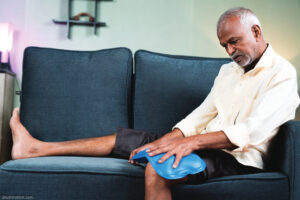 PHILADELPHIA—In the third Plenary Session of ACR Convergence 2022 on Monday, Nov. 14, researchers highlighted important findings on the efficacy and safety of sarilumab for polymyalgia rheumatica and the positive impact of community programs in promoting diet and exercise changes in patients with osteoarthritis.
PHILADELPHIA—In the third Plenary Session of ACR Convergence 2022 on Monday, Nov. 14, researchers highlighted important findings on the efficacy and safety of sarilumab for polymyalgia rheumatica and the positive impact of community programs in promoting diet and exercise changes in patients with osteoarthritis.
Sarilumab for Polymyalgia Rheumatica
Robert Spiera, MD, director of the Scleroderma, Vasculitis, and Myositis Center at the Hospital for Special Surgery, New York City, discussed the use of sarilumab as a potentially glucocorticoid-sparing therapy in a phase 3 study in patients with treatment-refractory polymyalgia rheumatica (PMR), one of the most common inflammatory diseases of the elderly.1,2
“Polymyalgia rheumatica is relatively easy to treat with glucocorticoids, but unfortunately relapses are common, resulting in prolonged courses of glucocorticoid therapy with its attendant morbidities,” Dr. Spiera said. “So we have recognized that a steroid-sparing therapy is an unmet need in PMR.”
Dr. Spiera explained that interleukin 6 (IL-6) seems to be a pivotal player in the pathophysiology of PMR. Blood levels of IL-6 are high in untreated patients and often rapidly fall after glucocorticoid treatment is started; concentrations of both plasma IL-6 and soluble IL-6 receptors correlate with disease activity. Moreover, persistent elevations in IL-6 are associated with relapsing, refractory disease, requiring extended treatment with glucocorticoids.3
Two recent placebo-controlled trials showed a potential benefit for IL-6 inhibition, including a randomized phase 2/3 trial of the IL-6 inhibitor tocilizumab, which showed that it was superior to placebo in terms of rates of remission, time to relapse and cumulative glucocorticoid dose.4,5
SAPHYR Trial Results
Dr. Spiera and his colleagues designed the SAPHYR trial, a randomized, double-blind, placebo-controlled phase 3 study, to assess the efficacy and safety of another IL-6 antagonist, sarilumab, in PMR patients aged 50 or older. Dr. Spiera pointed out that they studied patients who were refractory to steroid treatment, the PMR population with the greatest unmet treatment needs. To be eligible, patients had to have flared within three months of study entry while still on 7.5 mg or greater of prednisone.
Although initially designed for 280 patients, the number of participants recruited was lower due to the timing of the COVID-19 pandemic. The researchers randomized the patients into a treatment group of 200 mg of sarilumab subcutaneously every two weeks (n=59) and a comparator arm receiving placebo every two weeks (n=58). Participants in the treatment group had their steroids tapered rapidly over 14 weeks, compared to a more traditional 52-week taper in the comparator arm.

Dr. Spiera
The study’s primary end point was the proportion of patients in sustained remission at week 52. To meet this end point, patients had to achieve remission by 12 weeks, including complete remission of clinical symptoms and normalization of C-reactive protein (CRP). They also had to have no flares from 12 weeks onward, defined as having no symptoms or elevated erythrocyte sedimentation rate readings necessitating an increased glucocorticoid dose, with CRP levels still in the normal range while adhering to the defined steroid taper.
Dr. Spiera explained that some other studies of IL-6 inhibitors in PMR have used protocols with more rapid glucocorticoid tapers in both arms, whereas they compared sarilumab with a very rapid glucocorticoid taper vs. more traditional glucocorticoid doses in the comparator arm. “I think what we were replicating in the comparator arm was that in the real world, we try to take people off steroids,” he said. “Moreover, I think that is where the unmet need is—these patients who you could leave on steroids for a longer period.”
The study met its primary end point: Of the patients in the sarilumab arm, 28% achieved remission compared to only 10% in the comparator arm (P=0.02); when normalization of CRP was dropped from the definition of sustained remission, 32% of patients on sarilumab achieved it compared to 14% of patients on placebo (P=0.03). This trend continued in analysis of individual components defining remission, including the percentage of patients achieving remission by week 12, when the treatment group was on 2 mg of prednisone vs. approximately 8 mg in the placebo group.
“[The study protocol] had a very high bar for defining remission,” Dr. Spiera said.
These stringent criteria may have played a role in decreasing these remission rates compared to some other existing trials of IL-6 inhibitors in PMR that used more relaxed measures of remission. The rapid glucocorticoid taper may also have decreased remission rates in the treatment group compared with studies that allowed additional glucocorticoids at higher and/or longer doses.
The proportion of patients without any PMR signs and symptoms was also higher in the sarilumab arm compared with placebo, increasing as soon as week 2 and continuing to increase until week 52, with a similar trend observed when excluding patients who required glucocorticoid treatment as rescue therapy. Patients in the sarilumab arm were also less likely to flare after achieving clinical remission (17% vs. 29%; hazard ratio 0.56; P=0.02).
The cumulative corticosteroid dose was also higher in patients in the placebo group. Dr. Spiera pointed out that some of that was due to 52-week taper in this group, but the difference between the anticipated steroid use and actual steroid use, the difference in rescue steroids, was statistically significantly lower in the sarilumab group (P=0.02) A higher proportion of patients in the comparator arm also required additional glucocorticoids as rescue therapy compared to the sarilumab arm (59% vs. 32%; P=0.0053).
A variety of patient-reported quality of life and function measures, including the Short Form-36 Mental Component and Physical Component Scores, the Functional Assessment of Chronic Illness, the EuroQol-5 Dimension (EQ-5D) and the Health Assessment Questionnaire-Disability Index (HAQ-DI), favored sarilumab in a statistically significant manner, as did some of the physician assessments like the PMR-Activity Scale (PMR-AS).
Adverse events were as expected with sarilumab, and the frequency of serious adverse events was similar in both arms. In the sarilumab arm, 15% of patients had neutropenia, and another 15% had arthralgias. The comparator arm had more effects related to glucocorticoids, such as insomnia (16%). Dr. Spiera also pointed out that no patients in the sarilumab group had diverticulitis that required medical intervention from gastrointestinal perforation; this was a potential concern given the older patient age group and this rare potential adverse effect of IL-6 inhibitors.
When asked when he might use sarilumab in clinical practice, Dr. Spiera noted that for a patient not flaring on very low glucocorticoid doses, it might not be needed. “But that’s not the group of patients that’s our challenge,” he added. “I think I’d be interested in giving it to any patient who has previously flared or any patient at very high risk of glucocorticoid side effects.”
Diet & Exercise Interventions
Stephen Messier, PhD, director of the J.B. Snow Biomechanics Laboratory at Wake Forest University, Winston-Salem, N.C., presented findings from the WE-CAN trial, a study of the impact of a community-level diet and exercise program on knee pain in patients with knee osteoarthritis and overweight and obesity.6
The incidence of both osteoarthritis and obesity has been increasing in recent years, particularly in older adults. Osteoarthritis is the leading cause of chronic disability in older adults, one that significantly impacts patients’ function and quality of life. Obesity is a major risk factor for the development of osteoarthritis and for its progression, and individuals with more severe obesity tend to have more severe joint degradation compared with individuals of normal weight or underweight with osteoarthritis.7
Every pound of weight loss results in a roughly fourfold reduction in the load exerted on the knee during daily activities, which can impact pain. Although the link between obesity and osteoarthritis was once considered purely biomechanical, it has become clearer that other factors, such as decreased muscle mass and excess inflammation from obesity, may play a role in the link between the conditions.7
The WE-CAN randomized trial investigated whether interventions adapted from the IDEA trial could be implemented in non-academic, community settings.
Previous work has shown that a loss of 5% body weight provides some pain relief in obese people with osteoarthritis; a reduction of 10% doubles that pain relief. In addition to aiding weight loss, exercise provides other benefits in osteoarthritis, such as strengthened muscles, improved physical function and reduced pain.7
The current ACR guideline strongly recommends exercise for patients with knee osteoarthritis as well as weight loss for those who are overweight or obese.8 However, many physicians who treat these patients are not sure how to best help them implement these lifestyle changes.
Some academic centers have successfully implemented diet and exercise interventions in such patients. Dr. Messier noted that in the IDEA efficacy trial, in which he was also an investigator, the participants who received both a dietary and exercise intervention reduced their pain by 51% over 18 months as assessed by the Western Ontario and McMaster Universities Arthritis Index (WOMAC). That same trial found that exercise plus diet interventions were more successful at reducing pain, inflammation and knee joint loads than either intervention alone.9
WE-CAN Study Results
The WE-CAN randomized trial investigated whether interventions adapted from the IDEA trial could be implemented in non-academic, community settings.6 The trial took place at several rural and urban counties in North Carolina in such facilities as a local hospital community fitness center and a church recreation facility; study physicians trained commonly available community staff to diagnose knee osteoarthritis.
All participants were age 50 or older with knee osteoarthritis and a body mass index of at least 27 kg/m2. The researchers randomized the participants into a diet plus exercise group of a 414- or a 409-member attention control group. Ultimately, 80% of the participants completed the study.
The exercise component consisted of two 15-minute walking periods, separated by a 20-minute weight training session, three days a week. For the diet component, the participants ate and logged a reduced calorie diet of their choice, which could include low calorie meal replacement shakes. Members in the attention control group received nutrition and health education, including five one-hour meetings interspersed with phone meetings or health informational packets.
By 18 months, participants in the diet and exercise group had lost a mean of 8 kg vs. 2 kg in the control group (P<0.0001), which was also equivalent to a roughly 8% loss in body weight compared to a 2% loss. The diet and exercise group also lost an average of 9 cm in their waist circumference vs. 4 cm in the control group (P<0.001).
The study’s primary outcome was the difference in pain as assessed by the WOMAC between the groups at 18 months. Dr. Messier said, “The diet plus exercise group had less pain at both 6 and 18 months compared to the control group, with a 32% reduction in pain compared to 24%” (4.9 vs. 5.5; P=0.02). However, he added, “This between-group difference was modest and of uncertain clinical importance.”
Dr. Messier also noted that the patients in the diet and exercise group were also 20% more likely to achieve at least a two-point improvement of pain on the WOMAC compared with the control group (P=0.01), a difference he considered clinically meaningful.
Patients’ function as assessed by WOMAC was better for the patients in the diet and exercise group, with a 36% improvement compared to a 24% improvement in the control group (16.4 vs. 19.7; P<0.0001). Dr. Messier also noted that the diet plus exercise group showed a 41-meter improvement from baseline in their six-minute walk distance test; the control group was unchanged, resulting in a statistically significant difference.
The Short-Form Healthy Survey (SF-36) also showed a 20% improvement in the diet and exercise group compared to 6% in the control group in terms of health-related quality of life (41.3 vs. 37.5; P<0.0001). However, patients were not using fewer medications, and depressive symptoms were not significantly different between the two groups at the 18-month follow-up.
Dr. Messier also noted that the 24% improvement in WOMAC pain in the control group suggests that patient engagement and education itself had a positive impact, although not as much as more intensive and hands-on interactions that give patients more support to meet health goals. So rheumatologists should make a point of regularly discussing these topics with appropriate patients, even if they aren’t able to refer them to a setting that can provide more intensive engagement.
Dr. Messier concluded, “These data imply that community-based diet and exercise programs may be a practical alternative to academic programs in improving clinical outcomes in people with knee osteoarthritis, overweight or obesity.”

Ruth Jessen Hickman, MD, is a graduate of the Indiana University School of Medicine. She is a freelance medical and science writer living in Bloomington, Ind.
References
- Spiera R, Unizony S, Warrington K, et al. Sarilumab in patients with relapsing polymyalgia rheumatica: A phase 3, multicenter, randomized, double , placebo controlled trial (SAPHYR) [abstract]. Arthritis Rheumatol. 2022 Nov;74(suppl 9).
- Spiera R, Unizony S, Warrington K, et al. Resolution of PMR signs and symptoms in patients treated with sarilumab: A phase 3, multicenter, randomized, blind, placebo controlled trial (SAPHYR) in relapsing PMR. Arthritis Rheumatol. 2022 Nov;74(suppl 9).
- Lally L, Forbess L, Hatzis C, et al. Brief report: A prospective open-label phase IIa trial of tocilizumab in the treatment of polymyalgia rheumatica. Arthritis Rheumatol. 2016 Oct;68(10):2550–2554.
- Bonelli M, Radner H, Kerschbaumer A, et al. Tocilizumab in patients with new onset polymyalgia rheumatica (PMR-SPARE): A phase 2/3 randomised controlled trial. Ann Rheum Dis. 2022 Jun;81(6):838–844.
- Devauchelle-Pensec V, Carvajal-Alegria G, Dernis E, et al. Effect of tocilizumab on disease activity in patients with active polymyalgia rheumatica receiving glucocorticoid therapy: A randomized clinical trial. JAMA. 2022 Sep 20;328(11):1053–1062.
- Messier SP, Beavers DP, Queen K, et al. Effect of diet and exercise on knee pain in patients with osteoarthritis and overweight or obesity: A randomized clinical trial. JAMA. 2022;328(22):2242-2251.
- Bliddal H, Leeds AR, Christensen R. Osteoarthritis, obesity and weight loss: Evidence, hypotheses and horizons – a scoping review. Obes Rev. 2014 Jul;15(7):578–586.
- Kolasinski SL, Neogi T, Hochberg MC, et al. 2019 American College of Rheumatology/Arthritis Foundation guideline for the management of osteoarthritis of the hand, hip, and knee. Arthritis Care Res (Hoboken). 2020 Feb;72(2):149–162.
- Messier SP, Mihalko SL, Legault C, et al. Effects of intensive diet and exercise on knee joint loads, inflammation, and clinical outcomes among overweight and obese adults with knee osteoarthritis: The IDEA randomized clinical trial. JAMA. 2013 Sep 25;310(12):1263–1273.



